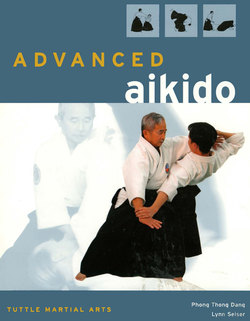Читать книгу Advanced Aikido - Phong Thong Dang - Страница 9
На сайте Литреса книга снята с продажи.
ОглавлениеPREFACE
In our previous work, Aikido Basics, we presented information pertinent to the beginning student. We went from finding a school, to the first day of class, through the basic aikido techniques. This book assumes that the reader already has that basic knowledge, training, and experience in the technical aspects of aikido. This work is about applying advanced concepts to the sophisticated and subtle aspects of aikido training and techniques. Though beginning and intermediate students may find this work a source of inspiration and encouragement, this book primarily focuses on the advanced students who want to broaden their knowledge base to include advanced throws and locks, combinations, counter techniques, and self-defense. Most importantly, the advanced students will gain an understanding of the application of advanced aikido concepts and principles that they can apply to training and the refinement of their basic practice.
Each waza (technique) presented in this book will receive a complete and thorough exploration and explanation. This book discusses and describes the waza in reference to its physical technical execution. Each waza will be discussed and described in reference to the sequential process of enter and blend, redirect and unbalance, throw or control, and let go and move on. This book discusses and describes waza in reference to advanced aikido concepts such as mushin (calm and empty mind) and musubi (connection). This complete and thorough exploration and explanation in description and discussion will lead to an understanding that should provide any student of aikido with the advanced knowledge and insight necessary to improve his or her technique and training in aikido.
However, readers should keep in mind that no one can learn aikido from a book, and no one can teach aikido from a book. One can only learn aikido through direct experience and training with a competent instructor. This, and all aikido books, is only a means of reference and guidance. After reading any portion of any aikido book, the best advice is to get on the dojo mats and train. Listen to your sensei and sempai (senior students) and stay open to suggestions and comments from your tohai (one of equal rank) and kohai (one of lesser rank)—it is only with an open mind that one can get a glimpse of the beauty of the art of aikido.
This book is divided into four parts. The first part offers insight into the inner development of the advanced practitioner; the second part offers insight into theories and concepts for the advanced practitioner; the third part offers insights into advanced techniques; the fourth part offers advanced applications. Finally, this book offers charts on techniques and concepts and two interviews with Sensei Phong Thong Dang.
The techniques and concepts presented in this work reflect the lifelong training and instruction of 6th Dan Sensei Phong Thong Dang, founder of the International Tenshinkai Aikido Federation, and the interpretation, understanding, and expression of those techniques and concepts by his student, 3rd Dan Lynn Seiser, Ph.D.
Tenshinkai means the association, or coming together, of heaven and Earth or heavenly heart and mind. It was the name given by O'Sensei Morihei Ueshiba to the uniquely fluid and powerful style of aikido coming from Vietnam. O'Sensei Morihei Ueshiba personally gave the responsibility of spreading this style of aikido throughout Vietnam and the world to Sensei Phong Thong Dang. Tenshinkai aikido is an Aikikai style of aikido that honors and respects its lineage and long association with the Aikikai Hombu Dojo, Aikido World Headquarters, the Aikikai Foundation, the current Doshu Ueshiba Moriteru, and the Ueshiba family.
